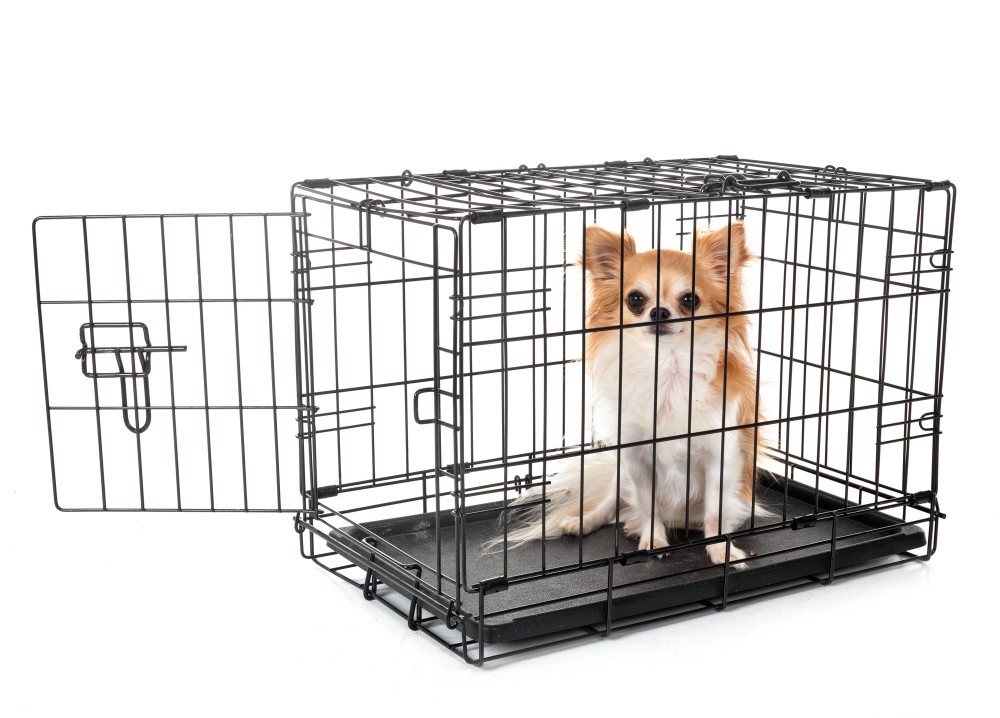Your little buddy will need to move out of her perfect crate space to accommodate her growing size as she transitions from puppy to adult. However, switching to a larger one shouldn’t be too difficult if your pup’s happy in her current container.
Choosing the right kennel size for your dog might be a challenge. First, you’ll need to consider her current size and the length of time you intend to keep her in a crate.
The appropriate crate for your puppy will be determined by her current weight and height and how much more she is expected to develop. Crates come in a wide range of sizes. Only by taking precise measurements will you be able to locate a kennel that is the proper size for your puppy.
You can save money by using a crate with a divider as your puppy gets older without buying a new one. However, when preparing to extend your puppy’s crate, you must consider the circumstances in which you confine your dog.
An exercise enclosure with litter and urine pads can temporarily restrain your pet while she is still crate trained. This is beneficial if the puppy is still apprehensive about being caged.
Can You Extend a Dog Crate?
The cost of relocating a dog can be significantly reduced using a vertical crate extension. However, stress and overwhelm, or simply a desire for some alone time, may lead dogs into crates on their own.
To accommodate your puppy’s growing needs, you should maintain enlarging the crate as needed. Also, look for kennels with divider panels so that you don’t have to buy new kennels when your puppy outgrows her old one.
When preparing to extend your puppy’s crate, you must consider the circumstances in which you confine your dog. A good amount of space for her to lie down, stretch out, stand, or even play is necessary for her confinement for most of the day.
To comply with airline regulations, your puppy’s cage must be high enough so that she may stand up straight and naturally. It must also be large enough to allow them to lie on the floor, recline, and turn about without difficulty.
When should you stop keeping your puppy in an enclosure? There isn’t a set time frame. But, if she’s mastered toilet training, it’s time to let her out of the crate.
When Should I Make My Dog’s Crate Bigger?
Your canine pet should be able to stand and turn around comfortably in the crate. It is best to get a large crate to fit your dog when they are fully grown.
Crates should be placed in a space where the family spends the most time, like the living room or den so that they can be easily accessible. Set up the dog crate with a comfortable bed or blanket.
Following the introduction of the crate, begin giving your dog its everyday meals inside the crate. Again, the container will be associated with a positive feeling.
You can restrict your dog to the crate for brief lengths of time when you’re home once they’ve been eating their everyday meals without showing any signs of fear or distress. Then, please give them a treat and have them come over to the crate.
Utilizing your standard command and a reward, put your dog inside the crate and close the door. You may initially keep the cage in your bed or close it in the corridor.
You’ll want to be willing to listen to your puppy when they beg to be let out to relieve themselves in the middle of the night. Dogs above one or two years old should not be separated from their human companions at first.
How Do You Adjust a Dog Crate Size?
The quickest and most straightforward approach to making a dog crate “smaller” is to add filler to reduce the amount of room available to the dog. For example, a non-porous material, such as a towel, cover, or bed, can be inserted inside the cage and then covered with a blanket or towel to reduce the cage’s height.
If the dog is confined to the crate for an extended period, it should be capable of standing up or turning around comfortably. Unfortunately, a puppy’s crate will become too tiny, forcing you to purchase a new one and causing your dog to be cramped in it until you do so.
Consider the refund policy or guarantee before adding alterations to a dog crate. For example, there is no way to get your money back if you cut, drill, or glue a hole in the container after purchasing it.
Use as much as is needed to accommodate the pet’s needs in the crate’s remaining space. Tying it in is an alternative to using glue or bolts in the box to secure your filler material.
This wire or string must be hidden from the dog’s view so that it would not injure or suffocate itself. Alternatively, you can use padding, including a blanket, to keep the dog from getting past the filler material you’re employing.
How Much Room Should a Dog Have in his Crate?
Ask your breeder for advice if you’re having trouble deciding on a crate size. All dogs from the same breed are not the same weight. Use a professional resource and combine it with your breeder’s understanding of the litter to get an appropriate size recommendation for your Frenchie or Cockapoo.
Make sure to provide sufficient allowance for your dog’s crate. We have a wide variety of dog crates to accommodate all our four-legged family members and their various needs.
Several ways to make your puppy feel more at ease and secure, including a puppy bed, a blanket, and even a doggie bed cover. It’s best to go for a full-size crate mattress as your dog matures.
When no one is around to keep an eye on your pup or dog, placing him in his crate is a good idea. Your puppy’s inherent curiosity may cause him to damage himself, or it may safeguard your home and furniture from his teeth.
Since dogs are inherently den animals, they crate invaluable learning because they intuitively clean up after themselves while they sleep. In addition, your puppy will be more likely to practice bowel control and keep it until you allow him out of his crate if it feels like a cozy den.














